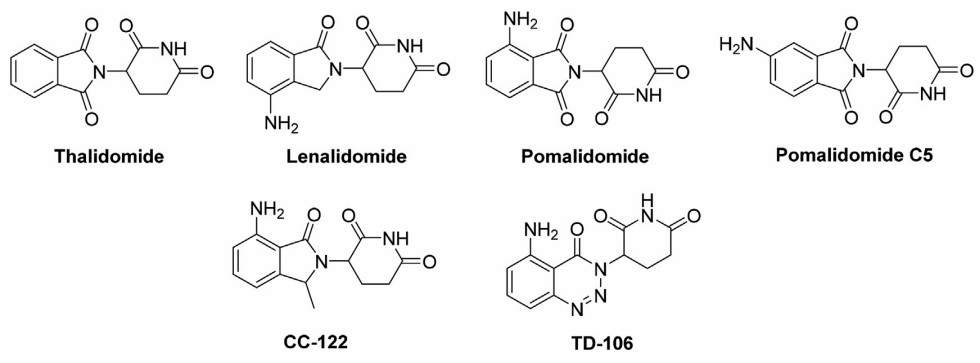A significant advancement of the PROTAC technology was the identification of small molecule-based E3 recruiting ligands. In particular, CRBN-based PROTACs have received more attention because of their promising therapeutic potential. PROTAC degraders using CRBN and other E3 ligases with known ligands have modular properties.
As a leading CRO in the pharmaceutical industry, BOC Sciences has established one-stop PROTAC platform. We are able to provide E3 ligase CRBN-based PROTAC development services. With comprehensive platform and expertise, we have focused on PROTAC molecules development to better assist our clients' new drug research.
Introduction of CRBN
CRBN, encoding a 442-amino-acid protein, is identified as a gene responsible for autosomal recessive non-syndromic intellectual disability. Cereblon (CRBN) is a ubiquitously expressed protein that is part of the cullin-4 E3 ubiquitin ligase complex, CUL4-RBX1-DDB1 (CRL4). CRBN serves as a substrate receptor of the CRL4 that recognizes substrates for ubiquitination and subsequent proteasomal degradation. CRBN binds to small molecules ligands through the glutarimide moiety and recognizes different neosubstrates depending on the structure.
Immunomodulatory drugs (IMiDs) are the first clinically approved E3 ubiquitin ligase inhibitors with specificity for the CRL4CRBN ligase. In myeloma cells, the anti-proliferative activities of IMiDs are linked to CRBN expression. According to the crystal structure of the CRBN complex-IMiD, the IMiDs bind a pocket on the CRBN C-terminal domain situated in a surface groove that is highly conserved across CRBN orthologues. IMiDs are anchored through the glutarimide functionality hydrogen-bonding to CRBN His380 and Trp382.
CRBN-based PROTAC
PROTAC is a heterobifunctional molecule consisting of the E3 ligase-binding ligand, and a ligand of target protein. CRBN-based PROTACs feature CRBN ligands that are the most frequently used E3 ligase ligands for designing PROTACs. IMiDs, such as thalidomide and its analogs, are common ligands of E3 ligase CRBN.
 Fig. 1 Small molecule ligands of E3 ligase CRBN
Fig. 1 Small molecule ligands of E3 ligase CRBN
The advantages of CRBN ligands:
- specific, strong, biophysically validated binding affinity for CRBN.
- acceptable physicochemical characteristics such as molecular weight, solubility, lipophilicity, lack of metabolic hot spots.
- well characterized structural information of their binding modes.
CRBN-based PROTACs are currently considered as promising therapeutic approaches. Recently, it was disclosed that the vast majority of PROTACs currently undergoing early clinical development stages are targeting CRBN, which appears to be emerging as the E3 ligase of choice in clinical trials. For example, both ARV-110 and ARV-471 use CRBN as the E3 ligase that is recruited to their respective targets, AR and ER, to catalyse their ubiquitylation and proteasomal degradation. Other PROTACs in clinical studies for CRBN include AC682, CC-94676, KT-413, NX-2127, NX-5948, CFT8634, CFT8919, CG001419, which cover cancer, autoimmune diseases and others indications.
Moreover, numbers of CRBN-based PROTACs targeting different disease-related proteins have been studied and developed. For example, ARV-825 consisting of pomalidomide and BRD4 inhibitor, can induce degradation of BRD4 and inhibited proliferation of Burkitt lymphoma cells at sub-nanomolar levels; MT-802 was developed based on thalidomide and Ibrutinib. It exhibited activities in degradation of wild-type and mutant BTK and inhibited chronic lymphocytic leukemia cells. CRBN-based PROTACs have performed well not only in cancer diseases but also in cardiovascular diseases, immune diseases, neurodegenerative diseases, and viral infections. To date, more than 60 proteins, including undruggable targets, can be degraded by CRBN-based PROTACs.
Our Services
- Developing CRBN ligands
- Identifying affinity of ligand candidates for E3 Ligase CRBN
- Stabilizing ternary complex formation of CRBN-PROTAC-Target
- Assaying the stability, cell permeability, solubility and tissue distribution of CRBN-based PROTACs
Our Advantages
- Customized CRBN-based PROTACs development
- Advanced technology and experienced scientific team
- Highly reliable and reproducible result
- Data analysis, detailed report with results and discussion
- Short turn-around time and competitive price
- One-stop PROTAC discovery services.
Related Products
References
- Fischer, E. S., et al., Structure of the DDB1-CRBN E3 ubiquitin ligase in complex with thalidomide, Nature, 2014, 512(7512): 49-53.
- Wang, C., Zhang, Y., Wu, Y., and Xing, D., Developments of CRBN-based PROTACs as potential therapeutic agents, European Journal of Medicinal Chemistry, 2021, 225, 113749.

 Fig. 1 Small molecule ligands of E3 ligase CRBN
Fig. 1 Small molecule ligands of E3 ligase CRBN